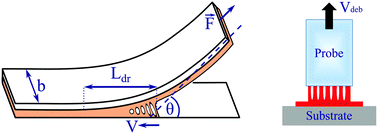当前位置:
X-MOL 学术
›
Soft Matter
›
论文详情
Our official English website, www.x-mol.net, welcomes your
feedback! (Note: you will need to create a separate account there.)
Linking peel and tack performances of pressure sensitive adhesives
Soft Matter ( IF 2.9 ) Pub Date : 2020/02/26 , DOI: 10.1039/c9sm02172h Vivek Pandey 1, 2, 3, 4, 5 , Antoine Fleury 1, 2, 3, 4, 5 , Richard Villey 6, 7, 8 , Costantino Creton 1, 2, 3, 4, 5 , Matteo Ciccotti 1, 2, 3, 4, 5
Soft Matter ( IF 2.9 ) Pub Date : 2020/02/26 , DOI: 10.1039/c9sm02172h Vivek Pandey 1, 2, 3, 4, 5 , Antoine Fleury 1, 2, 3, 4, 5 , Richard Villey 6, 7, 8 , Costantino Creton 1, 2, 3, 4, 5 , Matteo Ciccotti 1, 2, 3, 4, 5
Affiliation

|
The performances of Pressure Sensitive Adhesives (PSA) are generally evaluated using different loading geometries such as tack, peel and shear tests. It is difficult to link the behaviors of PSAs in these different geometries, and to predict the result of one test from another, because the confinement of a soft and dissipative material prevents the use of standard fracture mechanics, which separates the interface debonding behavior from the dissipation associated with the bulk deformation. We present here an original experimental investigation based on the modeling strategy proposed by Creton and Ciccotti[1]. Using instrumented versions of both peel and tack measurements, we compared the adherence performances of a series of model PSAs based on styrene–isoprene block copolymers, while identifying the mesoscale mechanisms at play during debonding. This analysis method allows us to model the contribution of the large strain rheology of the PSAs in the total work of debonding. We clearly show that both the adherence performances and local mechanisms can be closely related between peel and tack when considering both similar confinement and a similar strain rate of the fibrils that are spontaneously formed during debonding. While the overall adherence properties change by a factor of 3 between the different samples, the peel tests only present a minor +20% bias in adherence, which can be attributed to the combination of a 10% increase in the average stress and a 10% increase in the maximum strain of the fibrils. This improvement in the understanding of the PSA performances opens the way to a more sound mechanical design of PSA based joints.
中文翻译:

压敏胶的剥离和增粘性能的关联
通常使用不同的加载几何形状(例如粘性,剥离和剪切测试)来评估压敏胶粘剂(PSA)的性能。很难将PSA在这些不同几何形状中的行为联系起来,并难以预测另一种测试的结果,这是因为软性和耗散性材料的局限性阻止了使用标准的断裂力学,从而将界面剥离性能与耗散与整体变形有关。我们在此提出基于Creton和Ciccotti [1]提出的建模策略的原始实验研究。使用剥离和粘性测量的仪器版本,我们比较了一系列基于苯乙烯-异戊二烯嵌段共聚物的模型PSA的粘附性能,同时确定了脱胶过程中起作用的中尺度机理。这种分析方法使我们能够对PSA的大应变流变学在脱胶总工作中的贡献进行建模。我们清楚地表明,在考虑脱粘过程中自发形成的原纤维的相似限制和相似应变率时,剥离性能和粘着性之间的粘附性能和局部机理都可以密切相关。尽管不同样品之间的总体粘附性变化了3倍,但剥离测试仅显示出+ 20%的轻微偏差,这可以归因于平均应力增加10%和10%增加原纤维的最大应变。对PSA性能的了解的这种改进为基于PSA的接头更合理的机械设计开辟了道路。
更新日期:2020-04-01
中文翻译:

压敏胶的剥离和增粘性能的关联
通常使用不同的加载几何形状(例如粘性,剥离和剪切测试)来评估压敏胶粘剂(PSA)的性能。很难将PSA在这些不同几何形状中的行为联系起来,并难以预测另一种测试的结果,这是因为软性和耗散性材料的局限性阻止了使用标准的断裂力学,从而将界面剥离性能与耗散与整体变形有关。我们在此提出基于Creton和Ciccotti [1]提出的建模策略的原始实验研究。使用剥离和粘性测量的仪器版本,我们比较了一系列基于苯乙烯-异戊二烯嵌段共聚物的模型PSA的粘附性能,同时确定了脱胶过程中起作用的中尺度机理。这种分析方法使我们能够对PSA的大应变流变学在脱胶总工作中的贡献进行建模。我们清楚地表明,在考虑脱粘过程中自发形成的原纤维的相似限制和相似应变率时,剥离性能和粘着性之间的粘附性能和局部机理都可以密切相关。尽管不同样品之间的总体粘附性变化了3倍,但剥离测试仅显示出+ 20%的轻微偏差,这可以归因于平均应力增加10%和10%增加原纤维的最大应变。对PSA性能的了解的这种改进为基于PSA的接头更合理的机械设计开辟了道路。











































 京公网安备 11010802027423号
京公网安备 11010802027423号